“Everyone should visit Oklahoma”
- randyjoss
- Mar 20, 2023
- 11 min read

Oklahoma turned out to be, even more so than Arkansas, one of the MOST interesting and surprising places we never expected to enjoy. There were mountains, museums, beauty, terrorism, dust and oppression. There was definitely lots to enjoy and lots to learn.
Highlights included:
The Wichita Mountains & The Chickasaw National Recreation Area - Lots of great hiking and sunrises & sunsets over beautiful lakes
Oklahoma City - Finally we get to the First Americans Museum and it lives up to the hype
Tulsa - More good food, and the Greenwood Uprising museum, perhaps the last of our Civil Rights-related stops
The Dust Bowl - reliving the worst man-made ecological disaster in our history.
Hiking, Relaxing & Exploring
Wichita Mountains Nat’l Wildlife Preserve & the Chickasaw Nat’l Recreation Area
Ok, so our first impression of Oklahoma matched our stereotype. It was F-L-A-T. Really flat. And it seemed to go on forever, like there were only two colors in the world: the green of the fields and the blue of the sky. Randy was just finishing a great book on the dust bowl (Tim Eagan’s The Worst Hard Time) and kept waiting for the dust, but instead, up popped the Wichita Mountains. The Wichita Mountains National Wildlife Refuge is a preserve of close to 60,000 acres that was where the US first began to build back up buffalo herds after hunting them close to extinction. In fact, the original 15 buffalo in the park were transported there from the Bronx Zoo in 1907 because there were in Oklahoma at the time! We did see, and hear, a good size herd, but we couldn’t ever get close enough to them (thankfully!) to get a decent picture. The sound of “mooing” across the lake at sunrise is not one that Randy will forget soon though. :-)
The hiking at WMNWP was great, but the “real“ highlight was our campground. It was actually named the Doris Campground! We just couldn’t pass it up. Coffee and wordle by our Doris at Doris the campground by the lake in the morning sunlight was just TOO perfect.
Lastly our good friend Levi, one of 2 people we know from Oklahoma, had us supplied with lots of great recommendations for places to visit, but Joan’s CLEAR favorite was Braum’s ice cream. She maintains it‘s the best she’s ever had!
Oh, and clearly the ice cream caused the need for a parking lot nap!
. . .
One of Levi’s other suggestions, the Chickasaw National Recreation Area was our next hiking spot. And again, it wasn’t flat! It was lovely, with more hiking, lots of trees, the cute little town of Sulphur, and a chance to do some serious napping in the back of Doris. We were particularly thankful for the wonderful campground host there. The “host” in every RV park or federal/state campground is someone who lives there full time, generally helps keep the place clean, and welcomes & cares for the guests. Here, Larry not only let us pick out whatever campsite we liked best, but he also gave us free firewood and stopped by to chat frequently. And the bathrooms were really clean. :-) Who could ask for more??
Oklahoma City, OK
In OKC, our first priority was definitely to get to see the First Americans Museum (FAM). Ever since New England, the Native American presence - in museums, place names, cultural events, etc. -- had pretty much disappeared. In fact, in South Carolina when we asked about the Native American experiences relative to the large influx of enslaved Africans we were told, "Oh, they had all left by then." Period, end of story.
We had to go to Oklahoma to get the rest of the story.
Background:
We were not at all sure how to refer to Native Americans, so we did a little research and didn't find any clear consensus. Every tribe or organization seems to have a slightly different take on terminology, with American Indian, Indigenous People, and First Americans all used frequently, but Native American or Native Alaskan seemed to be the most broadly acceptable.
Oklahoma is actually the place to which most Native American Tribes "left" to go to. In the maps below from the FAM, you can see the spread of those tribes from pre-contact to today. Today, about 43% of Oklahoma belongs to Native Americans.
Before contact with Europeans, estimates Native American population are in the 5-18 million range. Yet, by 1907 there were fewer than 500,000 left. A decrease of more than 90% over 400 years. It was a holocaust of epic proportions, on the same scale as the Nazi slaughter of Jews in Poland and Cromwell’s crushing of the Irish. And it happened right here at home. Andrew Jackson’s Indian Removal Act of 1830 is perhaps the most famous of the US government's atrocious policies (continued IN SPITE of the Supreme Court ruling it illegal), but it's far from the only sin committed by our government against Native Americans.
The legacies of our treatment of Native Americans are coming to the forefront these days. Supreme Court cases especially concerning water rights (see this New Yorker article) and criminal justice issues have appeared on the docket in just the past 3 years. The Navaho Nation is actually arguing their current water rights case before the court as I type this. Interestingly, Justice Gorsuch, a Trump appointee, brings an extensive background in Indian affairs and has been the critical voice in support of the Tribes rights in these cases. This is his voice in a 5-4 majority opinion from 2020.

It has been heartening to see the dramatic uptick in knowledge and awareness of African American history in the past 10 years and our experiences on the Civil Rights trail this year have been amazing. One can only hope that the Native American experience will, at some point, gain the same prominence in US culture.
From systems of governance to the role of women to the Tribe’s relationship with Mother Earth, it seems to us there was so incredibly much that Europeans COULD have learned from the Native Americans that they encountered. Yet we assumed we knew what we were doing and pushed forward with our own view of "civilization". I see a similar problem, oddly, all the time in my students. They assume that the mathematical idea they are familiar with MUST be superior to a new one I’d like them to learn. That which is comfortable is VERY hard to unseat. The act of pausing to listen, the act of considering change, seems to be a very unnatural one for all of us.
Of course there was more to OKC than just the First Americans museum. We went on to the Murrah Federal building memorial to the 1995 bombing (for which Timothy McVeigh and his compatriots were convicted). However, it was yet another sobering experience. The group of them had become radicalized against the federal government after the siege at the Branch Dividian compound in Waco, TX and subsequently developed a plot to bomb the Federal Building in OKC. In the subsequent explosion, 168 people were killed including 19 children. Over 500 were injured. And 219 children lost at least 1 parent.
Nothing like the Murrah bombing has happened since then, but as evidenced by the Jan 6th chaos, we have more and more of these pockets of radicals who talk in intense and emotional terms about armed resistance to the government. Have we learned anything since the OKC bombing? Was there a change we should have made or a dialog that should have happened? We would have liked to meet more Oklahomans to get their opinions.
But we did have some lighter moments in OKC. It really is an underappreciated town to visit. We rented scooters and zipped through the downtown & the Bricktown neighborhood with its beautiful canals. Lots of fun public art and sights to see there.

A highlight though was visiting the Oklahoma National Stockyards which is one of the few remaining live auction sites for cattle in the US. About 500,000 cattle/calves come through here each year to be sold. They’ll go on to be either fattened up for slaughter or to replenish herds (ie creating more cattle). The night before, we stopped at the Cattleman’s Cafe next door to the Stockyard for a great steak dinner. Note the very midwestern approach to vegetables. :-)
At the auction the next day though, Joan had a bit of a hard time watching little calves get sold for $1 a pound in order to go to slaughter. They’re very cute, but their lives will not be long. However, almost 40% of US agricultural income these days comes from raising cattle and our steak dinner had to come from somewhere. She agreed that she hated watching the calves go by, but she loved her steak. As we talked about it though, we had to admit that maybe the kind of change to our diets that would be required to wean us off large scale meat production was hard for us in the same way that learning from the Murrah bombing was hard for others. Change is very very difficult and the best path to healthier behaviors is rarely obvious.
Speaking of better behaviors, the Warriors happened to be in town to play the OKC Thunder, so we went to watch. If the W’s could change their behaviors on defense they’d be in a lot better shape this season. Sadly, they lost.
Tulsa, OK

From OKC we continued heading east through a lot of Oklahoma oil country to Tulsa. It’s a lovely town that we wish we could have stayed longer in, but we were running out of time for Oklahoma because we had to be in Santa Fe by in 3 days.
The Greenwood Rising museum just opened 2 years ago and commentates the 1921 massacre that occurred when whites rampaged through the relatively prosperous Greenwood section of Tulsa destroying the neighborhood. The photos of the devastation are dramatic. Greenwood will probably turn out to be our last African American history site on this trip, however it’s a fitting bookend. Much like the coup d’etat & massacre in Wilmington, North Carolina (which was our first real Black history site) it was a frenzied mob of radicalized citizens infuriated over a story about a black man and a white woman. Using that pretext, they vented their anger in destruction, arson, and murder. I know it's just a larger scale version of the lynchings and beatings we say evidence of all across the South, but there something about the wholesale destruction of what is essentially a city that really knocked us back.
There’s much to unpack from that event, but in Tulsa we found the aftermath to be equally fascinating. Greenwood succeeded in rebuilding itself after 1921, but real civil rights change did not come until the 50s and 60s when segregation was abolished. Then, paradoxically the problem was that stores which previously hadn’t been available to the black community were now in competition with those in Greenwood. Since few white citizens wanted to shop in Greenwood, but blacks were increasingly shopping at white stores, the financial foundation of the neighborhood began to crumble.
As in so many black neighborhoods across America at the time the death blow was not a rito, but the building of a freeway. In this case highway 244 that cut the neighborhood in two. You can see the freeway just a block away from the museum. As heinous as the Greenwood massacre was, the subsequent years were horrible in more subtle but similarly tragic ways.

Not surprisingly though, the area continues to rebuild and develop in parallel with Tulsa’s overall growth. The local minor league baseball team (the Tulsa Drillers) has a beautiful stadium across the street from the museum. Nearby there are museums to both Bob Dylan and Woody Guthrie nearby as well as a BMX museum. There are copious displays of public art from Black, Latino, and Anglo heritages, and gentrification is the challenge of the day.

The Dust Bowl: Dumas & Dalhart, TX . . . And so many more small towns
If you enjoy reading history, the author Tim Egan will be a treat for you. Randy's dad told us about him and earlier in the trip we read The Immortal Irishman to get a better feel for the Irish experience in the States. Before we got to the southern prairie (aka the Dust Bowl) Randy was able to quickly get through Egan’s The Worst Hard Time. It’s one of those periods of history where there was SO much going on that the tragedies of the OK and TX panhandles get drowned out. However, it’s mind blowing to dig into. In fact, it was the perfect stop to end this part of the trip it seems so related to other disasters.
In other words, it happened:
Because of misguided government policies (and it reminded us of how government policy played a role in the decline of Clarence Thomas’s PinPoint home)
Because of a decade long drought that no one believed would really happen because they thought, "Rain follows the plow". (Really? And poop smells like roses?)
Because of the "civilized" men who pursued their own selfish interests regardless of the human, financial, or ecological cost
Because it was something that the Native American wisdom about Mother Earth would never have allowed to happen.
So, it should be the source of great change and learning.
Rather than describe what happened (the book does that plenty well), we’ve just reproduced some of the pictures from the various museums we visited. It simply is impossible to imagine these mile high, black clouds of dust bearing down on the farms and towns of the plains. It’s like something out of the Brendan Fraser ”Mummy” movies.
Land use has changed dramatically since the 1930’s and the area is much greener now. Many of the prairie grasses have come back. There are cattle grazing everywhere. So much is going well, yet there is still a great deal of dust and grinding poverty. We were reminded of both West Virginia and the Mississippi Delta. All were regions that were once on top of the world, but then fell precipitously. I’m sure all would like to be Made Great Again.
You might ask where the water is coming from now. As far as we can tell, it comes from pumping the Ogallala aquifer. Perhaps over pumping it. There is great concern that, much like with the Colorado river, we are overusing a finite resource and therefore in danger of causing permanent and potentially catastrophic damage. Kansas was recently in the news as the legislature there attempts to address a problem that’s been decades in the making. The agriculture that depends on the Ogallala makes up 30% of irrigated US agriculture though, so the issue goes far beyond Kansas To Oklahoma, Colorado, Texas, and New Mexico. Yet, as a geologist told us,
"The Ogallala is like a giant swimming pool. New Mexico and Kansas are at the shallow end and Texas is at the deep end. So guess where the problems will happen first?"
Again, we had to ask ourselves if our society learned what we should have learned from the tragedies of the 1930’s?
Oklahoma seems to be adept at pushing us to face that question, isn't it? It's like 2nd grade all over again: "Ok class. What did we learn from that experience?" And to think that we had considered skipping it an going straight to New Mexico. This might in fact be the state that we are most glad we visited. It was not lost on both of us how “flyover country” seemed to be such a good place to learn about some of the most important questions of our time.
As Joan said, “Everyone ought to visit Oklahoma”
To end on a lighter note. On the way out of OK we passed through Amarillo and the Texas Panhandle. There were two great stops along the way.
Our favorite Mexican restaurant so far was one we almost passed up because it was on the “other side of the tracks” in tiny little Dalhart, TX. The Dalhart Taqueria is nondescript concrete building without much of a sign indicating that this was the restaurant most highly rated in Yelp (yes, Yelp for Dalhart, Texas.) To be honest it looked like a storage building . . . or a gun range.
However, this was a quintessential “Joan” moment. We drove past and cringed at the building and the neighborhood, thought about looking elsewhere, but then we said, “what the heck!” and went in. Needless to say, we were too shy to take too many pictures, but it was one of those lunches we’ll never forget.

Our second little highlight was outside Amarillo, TX where we had to stop at the Cadillac Ranch . . . and just be tourists. Nothing deep or meaningful, but a wonderful spray paint moment.
Lastly, we promised Mike, of Spicy Mike’s BBQ in Amarillo that we’d make sure to feature him. He was very kind to us over dinner and he LOVED Doris. It may be the last BBQ that we have on this trip (at least that’s what Randy’s stomach is telling him), but if so, it was ending with a bang.

I think that’s enough for now. The thought for the day is probably just: Visit Oklahoma. You’re likely to learn a few things. Oh, and it’s beautiful.









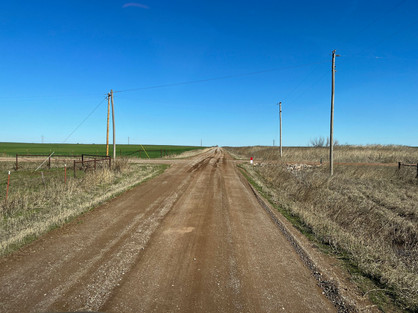





















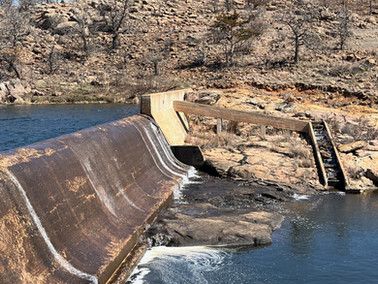





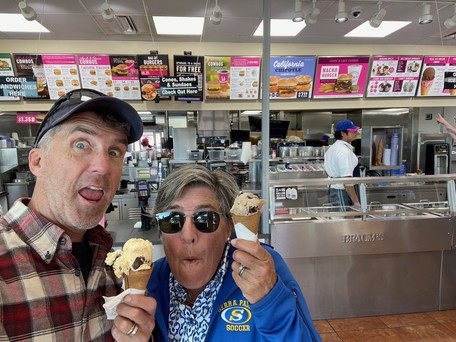















































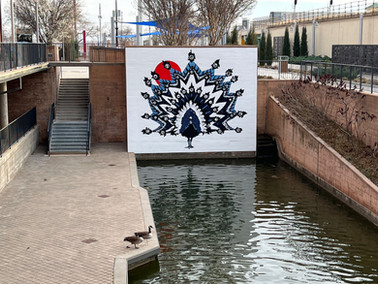













































































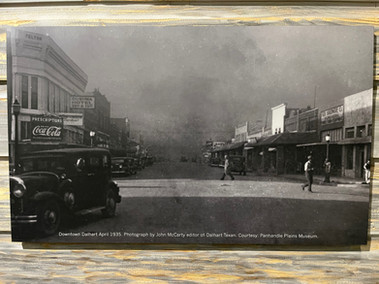







































So excited y’all enjoyed my home state! And LOVE the tag line for the Oklahoma blog!